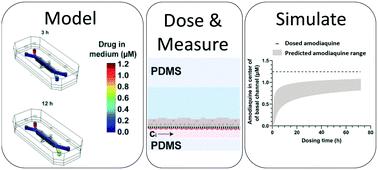Our official English website, www.x-mol.net, welcomes your feedback! (Note: you will need to create a separate account there.)
Simulating drug concentrations in PDMS microfluidic organ chips
Lab on a Chip ( IF 6.1 ) Pub Date : 2021-07-27 , DOI: 10.1039/d1lc00348h Jennifer Grant 1 , Alican Özkan 1 , Crystal Oh 1 , Gautam Mahajan 1 , Rachelle Prantil-Baun 1 , Donald E Ingber 1, 2, 3
Lab on a Chip ( IF 6.1 ) Pub Date : 2021-07-27 , DOI: 10.1039/d1lc00348h Jennifer Grant 1 , Alican Özkan 1 , Crystal Oh 1 , Gautam Mahajan 1 , Rachelle Prantil-Baun 1 , Donald E Ingber 1, 2, 3
Affiliation

|
Microfluidic organ-on-a-chip (Organ Chip) cell culture devices are often fabricated using polydimethylsiloxane (PDMS) because it is biocompatible, transparent, elastomeric, and oxygen permeable; however, hydrophobic small molecules can absorb to PDMS, which makes it challenging to predict drug responses. Here, we describe a combined simulation and experimental approach to predict the spatial and temporal concentration profile of a drug under continuous dosing in a PDMS Organ Chip containing two parallel channels separated by a porous membrane that is lined with cultured cells, without prior knowledge of its log P value. First, a three-dimensional finite element model of drug loss into the chip was developed that incorporates absorption, adsorption, convection, and diffusion, which simulates changes in drug levels over time and space as a function of potential PDMS diffusion coefficients and log P values. By then experimentally measuring the diffusivity of the compound in PDMS and determining its partition coefficient through mass spectrometric analysis of the drug concentration in the channel outflow, it is possible to estimate the effective log P range of the compound. The diffusion and partition coefficients were experimentally derived for the antimalarial drug and potential SARS-CoV-2 therapeutic, amodiaquine, and incorporated into the model to quantitatively estimate the drug-specific concentration profile over time measured in human lung airway chips lined with bronchial epithelium interfaced with pulmonary microvascular endothelium. The same strategy can be applied to any device geometry, surface treatment, or in vitro microfluidic model to simulate the spatial and temporal gradient of a drug in 3D without prior knowledge of the partition coefficient or the rate of diffusion in PDMS. Thus, this approach may expand the use of PDMS Organ Chip devices for various forms of drug testing.
中文翻译:

模拟 PDMS 微流控器官芯片中的药物浓度
微流控芯片器官 (Organ Chip) 细胞培养装置通常使用聚二甲基硅氧烷 (PDMS) 制造,因为它具有生物相容性、透明、弹性和透氧性;然而,疏水性小分子可以吸附到 PDMS 上,这使得预测药物反应变得具有挑战性。在这里,我们描述了一种组合模拟和实验方法来预测药物在连续给药下在 PDMS 器官芯片中的空间和时间浓度分布,该芯片包含两个平行通道,由衬有培养细胞的多孔膜隔开,无需事先了解其日志 P价值。首先,开发了药物损失到芯片中的三维有限元模型,该模型结合了吸收、吸附、对流和扩散,模拟了药物水平随时间和空间的变化,作为潜在 PDMS 扩散系数和 log P值的函数. 然后通过实验测量化合物在 PDMS 中的扩散率,并通过对通道流出物中药物浓度的质谱分析确定其分配系数,可以估计有效 log P化合物的范围。扩散和分配系数是针对抗疟疾药物和潜在的 SARS-CoV-2 治疗药物阿莫地喹通过实验得出的,并将其纳入模型以定量估计在衬有支气管上皮细胞的人肺气道芯片中随时间测量的药物特异性浓度曲线与肺微血管内皮有关。相同的策略可应用于任何设备几何形状、表面处理或体外微流体模型,以在 3D 中模拟药物的空间和时间梯度,而无需事先了解 PDMS 中的分配系数或扩散速率。因此,这种方法可以扩大 PDMS 器官芯片设备在各种形式的药物测试中的使用。
更新日期:2021-08-04
中文翻译:

模拟 PDMS 微流控器官芯片中的药物浓度
微流控芯片器官 (Organ Chip) 细胞培养装置通常使用聚二甲基硅氧烷 (PDMS) 制造,因为它具有生物相容性、透明、弹性和透氧性;然而,疏水性小分子可以吸附到 PDMS 上,这使得预测药物反应变得具有挑战性。在这里,我们描述了一种组合模拟和实验方法来预测药物在连续给药下在 PDMS 器官芯片中的空间和时间浓度分布,该芯片包含两个平行通道,由衬有培养细胞的多孔膜隔开,无需事先了解其日志 P价值。首先,开发了药物损失到芯片中的三维有限元模型,该模型结合了吸收、吸附、对流和扩散,模拟了药物水平随时间和空间的变化,作为潜在 PDMS 扩散系数和 log P值的函数. 然后通过实验测量化合物在 PDMS 中的扩散率,并通过对通道流出物中药物浓度的质谱分析确定其分配系数,可以估计有效 log P化合物的范围。扩散和分配系数是针对抗疟疾药物和潜在的 SARS-CoV-2 治疗药物阿莫地喹通过实验得出的,并将其纳入模型以定量估计在衬有支气管上皮细胞的人肺气道芯片中随时间测量的药物特异性浓度曲线与肺微血管内皮有关。相同的策略可应用于任何设备几何形状、表面处理或体外微流体模型,以在 3D 中模拟药物的空间和时间梯度,而无需事先了解 PDMS 中的分配系数或扩散速率。因此,这种方法可以扩大 PDMS 器官芯片设备在各种形式的药物测试中的使用。


























 京公网安备 11010802027423号
京公网安备 11010802027423号